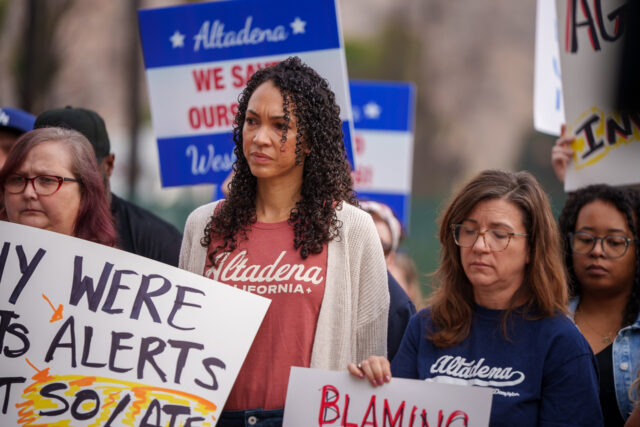By Solomon O. Smith | California Black Media
In the remains of a burned-out home in Altadena, Eaton Fire victims, activists, and news organizations gathered as residents reacted to the McChrystal Group’s report, a recently released review of emergency response during the Eaton and Palisades fires.
The independent After-Action Review of Alert Notification Systems and Evacuation Policies for the Eaton and Palisades Fires, released Sept. 25, is a 132-page report commissioned by the Los Angeles County Board of Supervisors. It chronicles events during the fire, analyzes the actions of emergency response organizations, and provides recommendations.
Altadena for Accountability, a coalition providing mutual aid for fire survivors, presented their collective response at the meeting. Many attendees felt the findings of the report will allow leaders to sidestep responsibility.
Organization leaders say Altadena, a community with a significant Black population, received a less urgent response from authorities and that the report’s language fails to show adequate respect for the city’s Black residents.
Kara Vallow, the owner of the fire-damaged lot, spoke about neighbors who died during the fire and the debt she feels leaders owe them.
“The number one job of our department heads and our county supervisors is overseeing our safety,” Vallow said. “These were not unprecedented, ‘unpredictable perfect storms.’ These are predictable storms that have precedent, that will continue to happen with increasing severity.”
The report was compiled by former Joint Special Operations Command (JSOC) Gen. Stanley A. McChrystal’s consultancy firm, the McChrystal Group. It was presented to the Los Angeles County Board of Supervisors on Sept. 30.
Erin Sutton, a partner at the firm, summarized the evaluation, pointing to its timeline of events, a map showing fire calls, warning areas, evacuation notices, and recommended fixes.
The findings were unflattering for the Los Angeles County Sheriff’s Department, the Los Angeles County Fire Department, and county leaders coordinating the response.
“Let me start by being clear about our primary finding. We found no single point of failure, but what we saw instead were a series of compounding weaknesses in systems, policies, and procedures that, combined with this unprecedented fire condition, created fundamental gaps in effectiveness and evacuations,” Sutton said. “This is important because it means the solution isn’t about one broken system or one failed process. There is a need for systemwide improvements across multiple interconnected areas across the county.”
Although the report avoids placing blame, it highlighted several notable issues: a lack of timely evacuation warnings, poor county infrastructure, and inadequate communication systems that left officers and firefighters reliant on cell phones. When power lines and cell towers burned, communication broke down.
Altadena’s warning system did not function as effectively as the Palisades’, a major complaint among survivors. Data from several other agencies—including LAPD, the City of Pasadena police and fire departments, and FEMA— was also missing from the report, leaders say.
“We have one-sided information, the county information,” Sutton said. “We know they work with surrounding jurisdictions, and that many have their own alerting systems, so they are part of the process and need to be included.”
Board of Supervisors Kathryn Barger, whose district includes Altadena, and Lindsey P. Horvath, representing the Palisades, coauthored the request for an independent investigation, expressing sharp criticism of the report’s findings.
Barger questioned Los Angeles County Sheriff Robert G. Luna about delayed evacuations and inadequate communication and pressed Fire Chief Anthony C. Marrone on the lack of coordination during the response.
“I just have to say that since the release of this report I’ve heard from many residents, some of whom are in the audience,” Barger said. “This report leads to more questions than answers, and a lot of anger.”
During proceedings, the phrase “west of Lake” described areas that received slower warnings and suffered the most damage. Supervisor Holly J. Mitchell noted the historical significance of redlining and discriminatory lending practices that contributed to Black and Brown communities in Altadena, acknowledging that residents’ experiences differed from the report’s portrayal.
Public comments—via phone, written correspondence, and in-person statements—largely expressed dissatisfaction and anger over the report’s lack of clear answers.
The board moved to accept the recommendations while discussing the need to revisit the report. In addition to the county review, Gov. Gavin Newsom’s office is investigating the fires, and fire victims and advocates have called for Attorney General Rob Bonta to investigate.
Eshele Williams, a licensed marriage and family therapist, told the press how she and other fire victims viewed the report:
“My house burned, my community burned, and there is no accountability for everything that has happened to us. We read the report and what it speaks is the obvious,” Williams said. “Give me accountability. Give us the action that we deserve. We are calling for the attorney general to investigate.”




